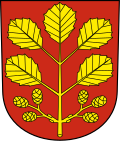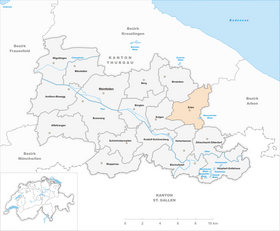Alder TG
| TG is the abbreviation for the canton of Thurgau in Switzerland and is used to avoid confusion with other entries of the name Erlen . |
| Alders | |
|---|---|
| Country: |
|
| Canton : | Thurgau (TG) |
| District : | Weinfelden |
| Postal code : | 8586 |
| BFS no. : | 4476 (Political Community) |
| former BFS no .: | 4479 (local parish ) |
| Coordinates : | 735088 / 268131 |
| Height : | 455 m above sea level M. |
| Area : | 12.19 km² (Polish municipality) 2.69 km² (local municipality) |
| Residents: | 3750 (December 31, 2018) |
| Population density : | 308 inhabitants per km² |
| Website: | www.www.erlen.ch |
| map | |
Erlen is a municipality and a town in the district of Weinfelden the Swiss canton Thurgau .
The political municipality, which has existed since 1995, comprises the former municipality of Erlen with its former municipalities of Buchackern , Engishofen , Ennetaach , Erlen and Kümmertshausen and the former municipality of Riedt, which previously belonged to the former municipality of Sulgen . The street village with the districts Erlen-Dorf, Ehstegen and Eppishausen on the main road Weinfelden - Amriswil and its intersection with the road to Constance has grown together more and more since 1950.
history
Ehstegen was first mentioned in 838 as Escislec . Before 1798, alder belonged to the so-called High Courts , which were directly subordinate to the federal governor in Thurgau . Eppishausen and a house in Erlen were part of the Eppishausen jurisdiction , while Ehstegen, as an abbot-Saint-Gallic fief, belonged to Oberaach and formed its own community until 1812.
In 1764 , the reformed church was built in Erlen, which until then had always belonged to the parish of Sulgen, a burial place and its own church administration were created in 1819, until Sulgen was completely dissolved in 1992. The Catholics of the community belong to Sulgen.
Erlen gained greater importance in the 17th and 18th centuries through the linen trade and dyeing. The Brunschweiler family, who moved from Schocherswil in 1652 , promoted the spread of spinning and weaving as a home industry and brought alders an economic boom. In the 19th century, mechanical embroidery was added as an industrial trade. Erlen has undergone major social and structural changes since 1951, when Lista AG, an expanding steel construction company, set up shop.
Between 1948 and 1951 the automobile racing event Preis der Ostschweiz was held four times in Erlen .
→ see also the history sections in the articles Buchackern , Engishofen , Ennetaach , Eppishausen TG , Kümmertshausen and Riedt (Erlen) .
coat of arms
Blazon : In red a yellow alder branch with five leaves and two three fruits .
It is a talking coat of arms in the colors of the Landvogtei , to which the village of Erlen, as a so-called High Court, was directly subordinate to in the period before 1798.
population
 |
| 1870 | 1950 | 1970 | 1990 | 2000 | 2010 | 2018 | |
|---|---|---|---|---|---|---|---|
| Political community | 3068 | 3176 | 3737 | ||||
| Municipal parish | 1127 | 1453 | 1857 | 2298 | |||
| Local parish | 431 | 611 | 1006 | 1232 | |||
| source | |||||||
Of the total of 3,737 inhabitants in the municipality of Erlen in 2018, 1,016 or 27.2% were foreign nationals. 1315 (35.2%) were Protestant Reformed and 1046 (27.10%) were Roman Catholic. At that time, Erlen had residents in 1919.
Attractions
The village of Erlen-Eppishausen is listed in the inventory of protected sites in Switzerland .
- Reformed church Erlen , built by Johann Ulrich Grubenmann
- Eppishausen Castle
Personalities
- Johann Joachim Brunschweiler (1759–1830), entrepreneur
- Jenny von Droste zu Hülshoff (1795-1859)
- Joseph von Laßberg (1770–1855), Germanist and writer
- Noëlle Maritz (1995–) football player
economy
Erlen is the headquarters of Lista Holding . The company is internationally active in the area of office, factory and storage facilities and in 2004 employed approx. 350 workers in Erlen. In 2016, Erlen employed 1,090 people (converted to full-time positions). 9.5% of these were employed in agriculture and forestry, 54.1% in industry, trade and construction and 36.5% in the service sector.
Web links
Individual evidence
- ↑ a b Thurgau in figures 2019 . On the website of the Statistical Office of the Canton of Thurgau (PDF file; 1.8 MB), accessed on April 28, 2020.
- ↑ Swiss land use statistics. Completed on July 1, 1912. Published by the Federal Statistical Bureau. ( Memento from April 12, 2016 in the Internet Archive )
- ↑ Permanent and non-permanent resident population by year, canton, district, municipality, population type and gender (permanent resident population). In: bfs. admin.ch . Federal Statistical Office (FSO), August 31, 2019, accessed on December 22, 2019 .
- ↑ a b Localities and their resident population. Edition 2019 . On the website of the Statistical Office of the Canton of Thurgau (Excel table; 0.1 MB), accessed on April 28, 2020.
-
↑ a b c d e f Verena Rothenbühler: Erlen. In: Historical Lexicon of Switzerland .
These sections are largely based on the entry in the Historical Lexicon of Switzerland (HLS), which, according to the HLS's usage information, is under the Creative Commons license - Attribution - Share under the same conditions 4.0 International (CC BY-SA 4.0). - ↑ a b municipal coat of arms . On the website of the State Archives of the Canton of Thurgau, accessed on December 8, 2019
- ↑ a b Population development of the municipalities. Canton Thurgau, 1850–2000 and resident population of the municipalities and change from the previous year. Canton of Thurgau, 1990–2018. On the website of the Statistical Office of the Canton of Thurgau (Excel tables; 0.1 MB each), accessed on April 28, 2020.








